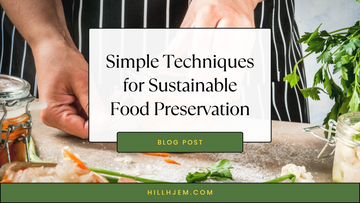
Have you ever experienced the pang of guilt when tossing limp vegetables into the compost bin? Or the frustration of watching perfectly ripe fruit turn to mush on the counter? Food waste is a global issue, with a significant environmental impact. But what if there was a fantastic way to enjoy delicious, homegrown flavors year-round, while also minimizing your environmental impact?
The answer lies in the art of food preservation – a practice that stretches back millennia and offers a chance to savor seasonal bounty long after it's gone from store shelves.
This guide delves into the idea of sustainable food preservation, offering a detailed exploration of various techniques and tips to get you started. So, grab your apron, unleash your inner homesteader, and get ready to transform your kitchen into a haven for seasonal flavors!
Natural Preservation
Before diving into more complex methods, let's not underestimate the power of simple storage. Mother Nature provides its own built-in preservation system for some fruits and vegetables. Certain varieties boast naturally thick skins or low moisture content, allowing them to store for weeks in a cool, dark, and well-ventilated environment.
Here are some champions of natural storage:
- Potatoes, onions, garlic, and winter squash are all superstars of pantry storage. Keep them in a basket or mesh bag to promote air circulation and prevent moisture build-up.
- Cabbage, Brussels sprouts, and kohlrabi can also last for weeks in the cool darkness of your pantry.
- Apples and pears, with their waxy skins, can stay fresh for a surprisingly long time when stored properly.
Remember, proper storage is key. Avoid plastic bags, which trap moisture and accelerate spoilage. Opt for breathable containers or open baskets instead.
Dehydration
Sun-drying is perhaps the oldest food preservation technique, and with good reason. Dehydration removes moisture from fruits, vegetables, and herbs, concentrating their flavor and creating shelf-stable ingredients that can be enjoyed throughout the year.
Here's how to get started with dehydration:
- Invest in a dehydrator for ultimate control over the drying process. Most dehydators come with adjustable temperature settings, allowing you to customize drying times for different foods.
- Sun-drying is a traditional and energy-efficient option, perfect for warm, dry climates. Choose a clean, well-ventilated location with plenty of direct sunlight. Slice your fruits and vegetables thinly and arrange them on drying screens. Cover them with cheesecloth to deter insects, and be prepared to bring them indoors overnight or during humid periods.
- Once dried, fruits like apples, mangoes, and berries make for fantastic healthy snacks or additions to trail mix. Dried vegetables like tomatoes, peppers, and mushrooms add a burst of flavor to soups, stews, and pasta dishes. Dehydrated herbs retain their potent aroma and can be used year-round in cooking.
Pro-Tip: Dehydrated fruits can be further processed into nutritious fruit leathers – a fun and healthy snack option, especially for kids. Simply puree your dried fruits, spread them thinly on parchment paper, and dehydrate for an additional few hours.
Fermentation
Kimchi, sauerkraut, yogurt – these culinary delights are all products of fermentation, a process that not only preserves food but also creates beneficial probiotics for gut health. Fermentation relies on the power of good bacteria to break down sugars in food, producing lactic acid as a byproduct. This acidic environment inhibits the growth of bad bacteria, extending the shelf life of your food.
Here are some fundamentals of fermenting at home:
- Invest in a non-reactive container like a glass jar or ceramic crock for your fermentation projects.
- Vegetables like cabbage, carrots, and cucumbers are popular choices for fermentation. Fruits can also be fermented, creating delicious condiments like chutney or fermented salsas.
- A salt brine is essential for creating the right environment for good bacteria to thrive. Experiment with different herbs and spices to add unique flavor profiles to your ferments.
- Fermentation is a time-dependent process. Depending on the chosen vegetables, temperature, and desired level of fermentation, it can take anywhere from a few days to a few weeks for your ferments to mature. Patience is key!
Reminder: Always follow trusted recipes and guidelines for safe fermentation practices. Improper fermentation can lead to the growth of harmful bacteria.
Pickling
Vinegar to the rescue! Pickling is a time-tested method that uses vinegar to create an acidic environment that keeps bad bacteria at bay. This technique not only preserves vegetables and fruits but also adds a delightful tangy twist to your meals.
Here's a glimpse into pickling:
- The pickling brine typically consists of vinegar, water, salt, and pickling spices like mustard seeds, coriander, and peppercorns. Experiment with different flavor combinations to create unique pickling profiles.
- The pickling process can be done via a hot water bath or a cold-pack method. Hot water bath canning ensures long-term shelf life, while cold-pack pickling is a quicker method, but the pickles need to be stored refrigerated.
- From classic cucumbers to colorful pickled onions and vibrant pickled peppers, the possibilities are endless. Pickled vegetables add a pop of flavor to salads, sandwiches, and cheese boards.
Pro-Tip: Use leftover pickling brine in marinades, salad dressings, or even as a base for a tangy soup.
Freezing
Modern freezers are energy-efficient marvels, making them a fantastic option for preserving a wide variety of foods. From fruits and vegetables to herbs and cooked meals, freezing allows you to capture the peak of the season and enjoy it later.
Here are some tips for successful freezing:
- For vegetables, blanching (a quick pre-cook) helps preserve their vibrant color, texture, and nutritional value. Simply blanch your vegetables in boiling water for a few minutes, then plunge them into an ice bath to stop the cooking process.
- Freeze fruits and vegetables in portion-controlled containers to avoid waste and make meal prep easier. Flash freezing individual pieces on a baking sheet before transferring them to containers prevents them from clumping together.
- Always label your frozen food with the date and contents. This will help you avoid freezer mystery meat (or mystery fruit) syndrome.
Remember, sustainable food preservation doesn't require a complete overhaul of your kitchen.
By incorporating these tips and tricks, you can extend the life of your harvest, reduce food waste, and celebrate sustainable practices, all while enjoying delicious home-preserved food throughout the year. So, get creative, embrace the bounty of summer, and embark on a delicious journey of sustainable food preservation!




